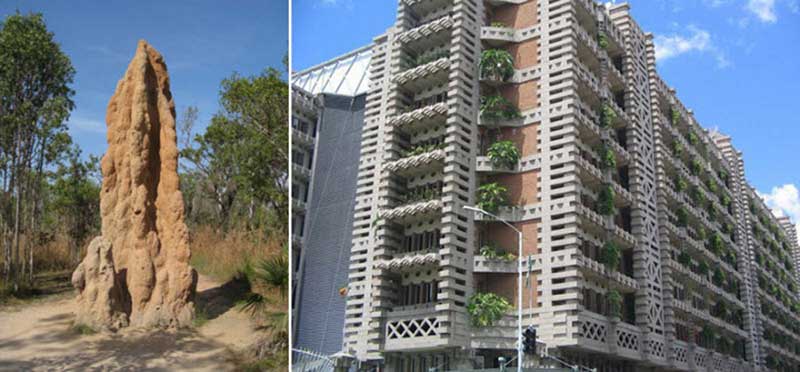- Biomimicry – an entire new world of super-powers
- These nature inspired emergency shelters have the ability to shape themselves
- Termites as inspiration for green air conditioning systems
- Carbon neutral cement inspired by the formation of coral reefs
- Floating Jellyfish Lodges clean polluted rivers and grow healthy food for the community
- Getting better at imitating nature’s intricate processes
Mother Nature has been abuzz with activity since the beginning of time, developing, improving and perfecting her already perfectly efficient systems through a continuous process of trial and error. We are surrounded by her intricate biological systems, offering us a wealth of knowledge. Architects and builders have been inspired by nature long before the term biomimicry was introduced, but after quite a long period of technological functionality and post-modern architecture, aesthetics and functionality once again have a stronger focus towards flowing spaces. And inspired by nature’s time-tested processes, they increasingly incorporate sustainable solutions to energy and climate challenges.
“Those who are inspired by a model other than Nature,
a mistress above all masters, are labouring in vain.”
– Leonardo Da Vinci
Biomimicry – an entire new world of super-powers
Biomimicry or biomimetics is the field in which biology, engineering and sustainability merge. Nature’s processes, systems and solutions are time tested, energy efficient and circular, inspiring innovation and new technology. Biomimicry unlocks an entire new world of ‘super-powers’. It copies life’s ideas and re-imagines them, instead of harvesting nature and its products. Every animal, plant, bacteria and fungus offers us entire genomes worth of sustainable, time-tested inspiration that can not only be used in architecture and construction, but also in production processes, transportation systems, infrastructure solutions and sustainable city development.

These nature inspired emergency shelters have the ability to shape themselves
Because of the global refugee crisis, emergency shelters are becoming increasingly important, and so is the design of these shelters. Haresh Lalvani, designer and cofounder of the Pratt Institute Centre for Experimental Structures, is creating a system based on biomimicry that will enable shelter structures to shape themselves, just like trees and plants grow and shape themselves. He is currently running tests with materials encoded with genomic instructions – giving objects built from these materials the ability to shape themselves by applying an external force such as gravity or wind. This makes it possible to rapidly deploy them in the event disasters such as earthquakes, floods or escalated political conflicts leave large numbers of people without shelter.
It’s no easy task to create ‘inherently temporary structures’, however. It requires high levels of forward and out-of-the-box thinking as well as futuristic levels of technology. In collaboration with metal manufacturer Milgo/Bufkin, Lalvani managed to create rigid 3D structures from flat metal sheets, perforated with variable openings in specific patterns. These structures have the ability to ‘grow’, based on the encoded instructions embedded in the material, much like trees grow based on the genetic information that’s embedded within their cells. These variable openings can either stretch or compress by applying gravity, giving the structure the ability to take on different shapes. The structures are made from just one thin sheet of metal and require no tools to assemble. They have the ability to bend into shape in under a minute and can be covered with an outer layer of textile to create a tent-like shelter. Their light weight also makes them easy to transport. Lalvani’s designs are suitable for various types of emergency situations and are a potential game changer in shelter design.
Termites as inspiration for green air conditioning systems
The Eastgate Centre in Harare, the largest shopping and office complex in Zimbabwe, is an incredible example of a building inspired by nature’s principles. Although the complex has no conventional heating or cooling systems, its temperature stays regulated throughout the year, consuming far less energy than similar buildings with conventional air conditioning systems. The centre, designed by architect Mick Pearce and Arup engineers, uses temperature regulation methods inspired by the self-cooling mounds of African termites. Inside their mounds, termites grow their own food: a fungus. The fungus thrives at constant temperatures of 30 degrees Celsius. The termites manage to perfectly regulate this temperature, even when it’s zero degrees outside at night or 50 degrees in the blazing sun during the day. This is achieved by the termites continuously opening and closing the cooling and heating vents throughout the mound. The termites create a system of adjustable convection currents in which air is sucked in at the bottom of the mound and travels up to the top through various channels in the mud. To regulate the temperature, the termites close old vents and dig new ones throughout the day and night.
The ventilation system of the Eastgate centre operates in much the same way. Depending on which is hotter, the air or the concrete of the building, the outside air that is drawn in by fans on the ground floor flows into the building where it is either cooled or warmed by the building mass. The air is then channelled through the floors and offices of the building, after which it is flushed out of the building through special chimneys. The complex uses less than ten percent of the energy of a similar sized building with conventional air conditioning systems. Apart from being highly efficient and eco-friendly, the energy savings also lead to twenty percent lower tenant rental prices compared to those in conventional buildings in the area. We’d say that’s a win-win-win.
Carbon neutral cement inspired by the formation of coral reefs
After studying how marine organisms such as coral reefs are formed – they take in minerals and CO2 and secrete calcium carbonate to form their hard outer structures – scientist and biomineralisation expert Brent Constanz from Stanford University developed new methods of creating carbon-neutral cement. Constanz managed to find ways to capture CO2 and dissolve it in seawater to form carbonate. The properties in this hard substance are perfectly suitable to create durable materials for use in construction and may ultimately replace cement, reducing the impact construction has on the environment. The process of dissolving CO2 in seawater to form calcium carbonate is a perfect example of how biomimicry can help us decrease our environmental footprint. To market this technology, Constanz formed the Calera Corporation. At their plant in California, waste CO2 gas from the surrounding industrial emitting sources is captured and transformed into calcium carbonate, which is produced as a fine, white powder that can be used to either supplement traditional cement or replace it. Each ton of calcium carbonate produced prevents the release of one ton of CO2 that would normally be emitted by traditional cement manufacturing.
Floating Jellyfish Lodge cleans polluted rivers and grows healthy food for the community
Wouldn’t it be amazing if we had floating accommodation that could clean the world’s polluted air and waterways while growing food? Graduate architect Janine Hung from the Philippines thought so too, and decided to create the Jellyfish Lodge, a solar powered structure that filters polluted water and air, while simultaneously producing healthy food in its interior aquaponic garden. The Jellyfish Lodges – Hung envisions more than one – are floating ‘homes’ which each feature a living area, kitchen, bedroom, bathroom, compost toilet and garden. The trash-gathering tentacles underneath the structure carefully collect floating rubbish without harming the environment. The water filtration system of the Jellyfish Lodge tests the water for toxicity and purifies polluted water through unique microbial digestion chambers. The treated water is then released back into the river or stored in one of the four cistern tanks on board. The sophisticated electrostatic system is responsible for purifying the air and helping the aquaponic gardens grow.
The Jellyfish Lodges are meant to inspire residents in the area to maintain them while reaping the benefits from the vegetables and fish that grow on board. The incredible Jellyfish Lodge concept received an Honourable Mention in last year’s Inhabitat Biodesign Competition. The judges commented: “The Jellyfish Lodge proposes to rehabilitate the world’s most polluted river slums by removing waste, treating water, growing food and purifying air all through solar power.” Hung said that her idea was born out of a desire to create a win-win situation between mankind and Mother Nature. She mentioned that the Jellyfish could either serve as alternatives for river slums or as mini hotel-type dwellings.
Getting better at imitating nature’s intricate processes
The concept of nature-inspired technology or biomimicry is gaining popularity all over the globe. Nature’s organisational methods and processes are influencing not only architecture and construction, but transportation systems, production processes, sustainable city development and infrastructure solutions as well. In this article, we have shown you just some of what biomimicry has to offer, but as new methods and materials start to evolve, we will get better and better at imitating nature’s intricate processes. There is an unlimited world of time-tested, sustainable concepts and processes to learn and draw inspiration from. If we continue to invest time and energy into studying them, we will be able to release a host of super-powers to take us into the future of architecture, engineering and construction.




